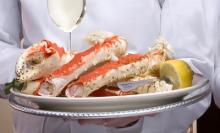Salt in the service of seasoning & the seasons, & a beautiful child born of need: the Atlantic fricot.

1. Is there any ‘Canadian’ food?
Those of us who follow food, or at least the history of its evolution, have heard the jibes at Canadian, and particularly Quebecoise, cookery. Not much of anything can be considered characteristically Canadian; most of what does pass for Canadian cuisine is heavy; all of it involves maple syrup; none of it worth eating is original; and the dialect that records the recipes is not only ugly but also indecipherable to outsiders.
Then there is The Lumby, a breakfast of more than three eggs served with piles of bacon, ham and sausage alongside pancakes the size of a discus. It supposedly originated at a hotel catering to lumberjacks in Gastown, Vancouver in about 1870 and appears to have been designed to kickstart the obesity crisis.
It all is unfair. While les Habitants and their Anglophone neighbors in Maritime Canada relish a number of rich, not to say heavy foods--the famous poutine of French fries, melted cheese and gravy comes to mind (as addictive as it is unhealthy)--eastern Canada can boast distinctive if sturdy traditional foodways too. Even the dreaded Lumby from the farther shore made some sense in an era when hewers of wood burned considerably more calories than their deskbound descendants in the towers of commerce. Besides, any cuisine that has given us something called pets de soeurs, or ‘nuns’ farts,’ and trous de soeurs (nuns’ holes) deserves preservation and promotion.
2. Don’t give up the greens, and add them to fricot.

One of the more appealing characteristics of this northern cuisine has been its dogged devotion to seasoning in a climate hostile for long wintry months to fresh herbs. The solution in an age preceding refrigeration for greens was salt, and the cooks of Quebec artfully found a way in various versions of herbal mixtures that they put away for those winter months. Some of them blend true fresh herbs but the most successful involve the onion family. There is something sublimely savory about the impact of slurried chive, onion, scallion and shallot under salt that sets a number of recipes from Atlantic Canada apart.
These salt herbs, herbes salées, can season soup, stew and fricot, the traditional Acadian staple that may be made with just about about any kind of meat or fish, whether freshwater, salt or shelled. The term neither exists in the cuisine of metropolitan France nor applies to Francophone kitchens alone. English speakers also say ‘fricot’ in Atlantic Canada, and the stew has been so ubiquitous that at one point it became shorthand for dinner itself to Acadian cooks and their families.
In either language the dish itself requires only a black pot, potatoes and whatever you have on hand to make a thick soup or thin stew, a hearty hybrid that is the humble gumbo of Atlantic Canada. It is plain food born of poverty and a bleak climate, and it is good.
Headliners could be birds, meat, fish or clams; potatoes pair with the protein and sometimes, especially for fish or clams, salt pork goes into the stock thickened with flour and, usually but not inevitably, flavored with those herbes salées. Some cooks brown the meat first, others do not bother; big hunks can simmer before being shredded, or smaller chunks fill the pot from the start.
Vegetables, even roots, seldom make an appearance in fricot, for much of Maritime Canada was a world without electricity until the second half of the twentieth century.
To keep things rich and cheap, and tasty, a fricot of simmered meat should include dumplings but do not add them to your fish fricot. Acadian dumplings may be based on flour or potato, and are called variously pates, poutines, poutines blanches or grand-peres and its equivalent, ‘grandfathers’. The term for thin little square dumplings is ‘handkerchief’, or pates en mouchoir de poche. These dumplings descend via austerity from their English ancestors: In the hardscrabble Maritimes, dumplings lack even the fat, whether butter, lard or suet, of their counterparts in Britain and the American south.
3. An appropriate detour in the direction of chowder.
The variations in technique depend on both the proclivities of the cook and the region where the particular fricot began. The concept is elastic, and in the case of fish and clams, it blurs toward chowder, called chaude or tchaude in both Nova Scotia and the Maritimes. The great Jasper White, whom we dare not doubt despite his dearth of citations, dates chowder itself to the first half of the eighteenth century, yet another reason to celebrate the culture of the era.

So much, however, for conviction; as White explains, while “it is certain that chowder comes into existence at some point in this period, everything else is speculation, of which there is no shortage.” (White 19) Francophiles claim that the term ‘chowder’ decends in direct line from‘chaudiere,’ a cooking pot, but the Old English term for fishmonger from Cornwall and the West Country, variously ‘jowder’ or ‘iowder,’ can claim equal etymological ancestry.
Alan Davidson wonders whether chowder originated in the meeting of trappeurs with their chaudieres and the Micmac with their taste for soft shell clams (Davidson 402), but no evidence supports his theory and in fact the earliest chowders relied on cod, not clams. At any rate the editor has reservations about Davidson’s research skills when it comes to recipes (but he sure can catalog species of fish). Davidson has committed the mortal heresy of adding tomatoes to Rhode Island chowder (Davidson 423), which should be clear. It includes neither milk nor fruit but relies instead on a stock of clam or, sometimes, chicken. Europeans like him ought out of prudence to steer clear of chowder for any number of reasons.
Karen Hess, an American, believes that chowder “came to the Colonies, as well as Quebec, by way of the English” (Hess 66) but perhaps all of this misses a certain point.
The nationalist argument may not be worth much, because as John Thorne and White each observes, neither France nor Britain lays claim to chowder and you cannot find it on menus or at home in either country, let alone in contemporary cookbooks. If you do find something in a restaurant called ‘chowder’ do not be fooled. It will not resemble it and will not be good, so if you must eat chowder in Europe, open an American can.
As an aside, however, in fairness it must be said that it is just about impossible to find decent chowder in the United States outside New England. An exception, however, is Shaw’s Crab House in Chicago.

Shaw’s Crab House – good chowder and crab legs too.
To return to our ostensible subject, or at least initial digression, on reflection Hess may have a point. The void in appropriation may disfavor France for, as Thorne notes, “[t]he French, who are rarely reluctant to claim a dish as their own invention, make no great effort to set forth any proprietary rights.” (Thorne 158)
Nationalism is a discredited if not evil manifestation of will to the politically correct, and on this sole occasion we may be wise to follow their lead, however reluctant and regretful we may be as momentary comrades. Thorne, who we do not by the way consider guilty of sanctimony of the political or any other form, takes our prize for insight into the origin of chowder. As he explains, nationality is unhelpful here:
“But think of its parentage in terms of place and all uncertainty falls away. Chowder is the natural child begotten in the great convergence of fishermen off the North American coast, where its parents somehow, somewhere, met and fell in love.” (Thorne 158)
This may be precisely the kind of speculation that White cites, but it is good speculation. Thorne is confident in his theory, and finds the affair that he describes as fated as the attraction of Helen and Paris. “Chowder was the inevitable outcome of a sea cook’s confrontation with salt pork, ship’s biscuit, and a freshly caught cod.” (Thorne 158) Thorne dares us to prove a negative. If, he reasons, you think about conditions in the galley of a fishing boat on the Georges’ Bank in the Georgian years, then “you will come to wonder not how chowder came into existence but what else they ever found to eat.” (Thorne 159)
Whatever the patrimony (and matrimony too; no letters please), it would appear that chowder, which upon conception rapidly spread throughout Atlantic Canada and New England, never gained much traction to Europe. It did get there; Tobias Smollett wrote in 1762 that one of his character’s heads “sings and simmers like a pot of chowder” and Hannah Glasse published a recipe in her 1763 edition of the Art of Cookery Made Plain and Easy. As White notes, however, “although the English seem well aware of chowder during the eighteenth century, it all but disappears from their repertoire soon thereafter.” (White 20)
Glasse may have published a recipe, but that does not mean that anyone east of Newfoundland other than Smollett ever tried, let alone took to it. The great botanist and explorer Joseph Banks certainly had not noticed. While collecting samples in Newfoundland during 1766, he wrote that chowder
“is Peculiar to this Country tho here it is the Cheif food of the Poorer & when well made a Luxury that the rich Even in England at Least in my opinion might be fond of. It is a Soup made with a small quantity of salt Pork cut into Small Slices a good deal of fish and Biscuit Boyled for about an hour unlikely as this mixture appears to be palatable I have scarce met any Body in this Country Who is not fond of it…. ” (quoted in Thorne 157-58)
Chowder remained a staple for the landed poor too, well into the middle of the twentieth century. Thorne recalls his mother telling him that in Maine, chowder “is what you eat when you can’t afford anything else” (Thorne 156), which brings us straight back to fricot.
4. For the night before the paycheck or the morning after the binge.
If you are really broke, all you need for a filling fricot are some potatoes, an onion and those herbes salées. Then you can build fricot a la belette, that is, weasel fricot; Acadians say the weasel ‘went on by’ and escaped the pot. Less lyrical theorists say that belette refers to the cook who was clever as a weasel in saving money by omitting all the meat.

Language evolves in a wry way, so through wordplay the weaselly belette became a bezette, or nincompoop, fricot on Prince Edward Island, where the cook who ‘forgot’ the meat or fish for her fricot may also have been a fool. More prosaic souls call the same thing butter, salt herb or potato fricot (no italics here despite our standard usage; Anglophone speakers are intrinsically less flamboyant). Whatever they called their frugal fricots, Acadian cooks accompanied them with bread and molasses, both to stretch scarce loonies and boost the calorie content of the meal.
Drunkard’s soup is another dish for the destitute. It resembles nothing so much as a thinnish fricot made with bread instead of potatoes and the merest tithe of salted meat. Drunkard’s soup also shares kinship with the earliest chowders, which did not include potatoes either, whether on land or at sea.
Depending on your chosen mythology, drunkard’s soup gained its name because it is cheap enough to feed the family of a father who drank away the money for food, because it is fast and easy enough to make with minimal pain for the unfortunate soul with a hangover, or because it will cure one. There is not much to drunkard’s soup and nothing at all wrong with it. If you dice and brown a little salt pork, chop some onion and fry it in the rendered pork until golden, toss some cubes of bread into the mix, then throw it into a moderate oven to toast the bread before simmering the mess in beef stock and those ubiquitous herbes salées for about an hour, you have got some drunkard’s soup, which inappropriately enough is very nice with a few bottles of beer.
Recipes for salted herbs, some fricots and drunkard’s soup appear in the practical.
Notes:
- It remains unclear to the Editor why dumplings are forbidden from fish fricots but the rule appears hard and fast.
- Nuns’ farts are pastries filled with a mixture of brown sugar and cream. Nuns’ holes are essentially small savory doughnuts.
- We will return to the subject of chowder and its origin in an appropriate Number.
Sources:
Julian Armstrong, A Taste of Quebec (New York 2001)
Marielle Cormier-Boudreau & Melvin Gallant, A Taste of Acadie (Fredericton, NB 1991)
Alan Davidson, North Atlantic Seafood (New York 1979)
Karen Hess, “La Cipaille and Sea Pie,” Petite Propos Culinaires 38 (August 1991), ‘Notes and Queries’ 66
John Thorne, Serious Pig (New York 1996)
Jasper White, 50 Chowders (New York 2000)

